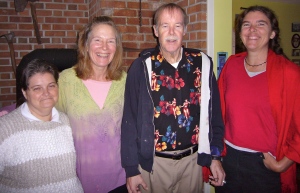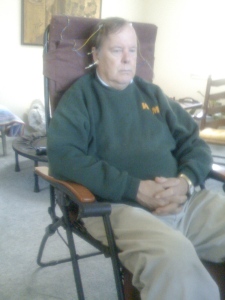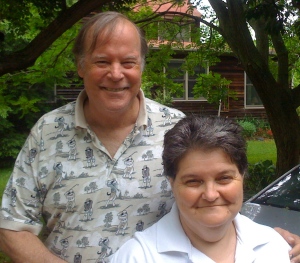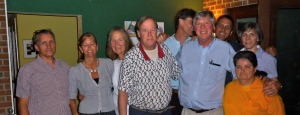How does the Family Emotional Process “Guide” Relationships?
This is a sister’s self-report on a five-year effort to enlist family members to support and enable her bother to stabilize his life after multiple hospitalizations for manic-depressive disorders.
Currently mental health see’s the problem as in the individual. This focus seals the family projection process as the reality. One person is sick and needs treatment.
A revolution in mental health brought the evolutionary idea of the family as a unit -governing the development of individuals – into view. Over long periods of time we can observe how anxiety is managed in relationships. We can observe how people’s ability to function is constantly changing depending on the shifting landscape. The most basic idea is that relationships process can alter brain chemistry, turns genes on and off, (epigenetic), and transfer stress and so influence the way people are able to function.
When one person has been diagnosed with mental illness often family members, in an effort to get the other to behave, have become very distant or over involved. Family members have little aware of the automatic nature of the family emotional process. They are often very frustrated with the person who has become “difficult.”
A system’s view allows any motivated family member to back up, to be less controlled by the automatic reactivity and to begin to observe the impersonal forces pressuring members of the family unit. One begins to observe how anxiety is distributed “unfairly,” resulting in one person, often telling the other person what to do.
In general, the weaker members of the family draw negative attention. Family members react and become either over or under involved with the seemingly “weaker one.” Thus, without knowledge one begins to “mess up” relationships in the effort to “help” the other.
The challenge is for the family members to undo the “mess” by observing the impersonal family emotional process and to work on seeing and altering his or her part in the family problems. There are automatically “instinctual” like process that guides our behavior. Under stress people tell others what to do and or are critical of them. Eventually family members run out of patience, know they are over their heads and get distance from the one who is acting strange. Often family member are handed over to professionals and the family feels relived.
How do we know what “help” really is?
What kind of a measuring stick will we use to notice if we are making a positive difference in another’s life course?
Guidelines Developed from Family Systems Theory:
- The emotional process consists of four automatic behaviors which are activated by increasing anxiety and which then absorb and “fix” the anxiety:
- The four “evils:” 1) distance, 2) conflict, 3) reciprocal relationships (one up and one down) and 4) the family projection process.
- The fifth way is differentiation of self (DoS). The process of DoS involves one person being able to comment on the process between people in a neutral way leaving self out. Initially people begin to “see” the process and comment on it using self, as in: I see what you’re doing and its wrong. Eventually people can get to the point of saying things like: How is “X” impacting you and your mother/father/wife/brother? Genuine curiosity can emerge from observation and people feel freer to be their more authentic self.
- The process of change: Initially people object to anyone who is commenting on the emotional processes. They are critical of the observer. They tell the observer stop doing that, change back to the way you were, obey the rules of common decency, your wrong. If one can persist without reacting and take responsibility for being an irritant, then eventually family members can accept the one who is “commenting, as perhaps bit odd but not so-so threatening.
- The process of DoS from the grip of the emotional system works over time. It starts with one individual, no longer willing to be ruled by the automatic process, who can observe and has the courage to comment on relationships process. Eventually more and more individuals in the system are freer to observe the system without the fearful habits of the past ways of relating (criticism, distance and undermining of others) taking over the system. The family emotional process has weakened and DoS has changed the relationships system. The individual who is attempting to differentiate a self is drawing more negative attention to self as they are more capable of managing the anxiety than the weaker more focused on people. Over time more individuals become aware of emotional process that are not useful and are able to resist habits from the past way of functioning and now demonstrate greater knowledge of the system and independence.
The story of Drew, his sister and the changes in the family: Drew is the youngest brother of a brother seven years older, and a sister nine years older. The parents had both become disorganized after WW II and had sever drinking problems. The three children were adopted by their maternal grandparents when Drew was almost two. Due to his mother drinking Drew had trouble learning. Drew has a very pleasing personality and a good memory; however, his work and personal life were both impacted by his difficulty functioning.
Around the time of his grandmother’s death in 1972, he had a manic episode and was treated at the age of 20. The next episode occurred in his late thirties, after the death of his maternal grandfather in 1978, which included a brief hospitalized. He was hospitalized one other time when his second wife noted that he was acting bizarrely. At the time. Drew was working for his paternal uncle and living on the pottery property. His job was changing and he was asked to move to North Carolina. Once there this marriage began to disintegrate and he fell into a depression. Eventually, his brother and sister supported his moving back to Williamsburg. Here he found a new job and married again. Eventually he returned to work at the Pottery Factory, run by his uncle. As time went on Drew and his wife became more isolated from the family. Then in 2006 his paternal uncle died.
Drew’s father had died when he was 16 and this paternal uncle had functioned as a kind of a distant father figure. Drew had worked in odd jobs in the family business and had hoped to be left something in his uncles will and had been disappointed. His uncle’s new wife had taken over the family business and there was a great deal of family turmoil around this death and the changes in the business.
Family members noted that Drew had become more disorganized and was acting in a bizarre way. Among other things he was playing golf in the parking lot at work and told people he was Arnold Palmer’s caddy. One of his cousin, Charles, who lived locally, took responsibility for helping Drew seek professional help. The sister lived in Ct. and asked a cousin, Liz, (who lived about half way between the sister and the brother) to enable a family reunion monthly with Drew and his wife, Margie. During the first few months Drew had three short term hospitalizations for bipolar illness and was give antipsychotic medication. Drew’s condition worsened until he was no longer able to care for himself and was admitted to the Williamsburg State Hospital with the help of his cousin Charles.
Over a three-month period, Drew’s condition deteriorated and he developed Parkinson’s like symptoms. Family members believed he was being overdosed at the state hospital as among other issues he had lost over thirty pounds and was put on suicide watch. This was the same hospital where Drew’s father had died at around the same age Drew was then. In response to the crisis the sister and various family organized an effort to provide a safe place to recover, at a cousin’s farm, while offering an aftercare program. A formal letter was required to enable the state hospital director to release Drew into the families’ care. The aftercare program was to take place at his cousin Liz’s farm, where there was a local and helpful physician, a steady social worker and the sister could come and be with his for the first ten days and then return monthly.
The goals were: 1) Diminish fear in relating to her brother. 2) Keep the group surrounding him focused on not knowing what Drew should be doing but only what they observe and then did. 3) Have each person to write down what seemed to work to lower his or her own anxiety and or feelings of distress within self. All questions and comments were to be entered in a journal available for all to see. 4) The sister offered Neurofeeback for each person and for her bother. 5) The brother and his wife were asked to participate in a fifty-fifty relationship, in which they did something difficult to accept help from others. This involved: moving from a collapsing house, moving to a trailer, having his teeth fixed, daily showers, walks and vitamins, seeing an MD to monitor medications, and monthly family meetings and agreeing to be videotaped so that each person could learn from viewing the interactions. After the first NeuroCare training session, the brother stopped shaking for a few moments and the sister began videotaping after that occurred.
These family meetings continued once month for several years. The discussion often focused on summarizing the changes that had occurred. Humor and paradox were used to bring up fearful issues, such as dying in the state hospital at the same age when his father died, and various behavioral issues. After any intense conversations, all would relax using neurofeedback. The sister made copies of the videotapes and gave each persona copy. Often Liz and her family would watch the videotapes and discuss how to manage self in the upsets.
Changes in Extended Family: Many people in the extended family could visit and support my bother. This was a major change in family patterns.
Five family members offered money to help support him until he got on disability. People who had been afraid of persons in a manic episode began to
have confidence and make better contact with him. Years of being in better contact with people in my family helped to create an environment in which change could occur. Significant changes happened both in the family and in my brother, for which I am grateful. There have been no further hospitalizations and a documented change in cognitive and affective functioning.
Important Factors
- Being with family members who can manage self, reducing blame.
- Shifts in the extended family contacts.
- Allowing the brain to reorganize using NeuroCare.
- Setting limits.
Implications for Treatment:
Currently society legitimizes a focus on treating individual who have symptoms, blinding the family itself from understanding how to see what constitutes and promotes effective change in the family as a system.
Does diagnosing people, simply adds to the problems? Diagnosing one, and turning the situation over to processionals, suggests that families cannot participate and adapt to the illness of a family member. When mental illness or other serious symptoms appear, often the family members feel helpless. People have a hard time understanding how the development of symptoms in one person may be an instinctive way for the family as whole to survive.
If family members understand a systems way of seeing symptoms cause and effect thinking is put aside. Those who are able and willing can move towards the person with symptoms, in disciplined way. When this change happens, more people absorb the overall anxiety.
If this one case study has implications for further research, then future pilot program would design a broader learning based training paradigm for the family members. This would be a major shift in how mental illness is understood.
Training for family members would occur along with those who were currently expressing symptoms. A deeper understanding of the family as a unit and training for motivation individuals would replace conventional individual diagnosing and treatment.
Reprinted from Family Systems Forum, a publication of the
Center for the Study of Natural Systems and the Family, Volume 9, Number 3,
Fall 2007
It is one thing to consider a broad picture of
mental health. It is an entirely different matter when a close family
member is diagnosed with a mental illness. When the latter happens, the
pressure is on for action: What am I going to do now? What can you
do if you cannot see both the forest and the tree? Seeing the
forest but not knowing the tree is a broad view but partially blind.
Seeing the tree without knowing the forest lacks perspective. One without
the other does not make for a systems view. This paper will present both
a broad and a personal look at a bipolar diagnosis in one family.
Mental Illness Oversimplified
Mental illness can be over-simplified as the
inability of one person to “fit in” with a family or a society’s expectation of
normal behavior. Animals, including pets, can behave in strange
ways. “Diagnosing” pets or people is said to lead to proper
treatment. After all, we need to know what to do about the “condition.”
Here we see the pressure exerted by the forest for trees to grow
properly. A tree must bend to the conventional wisdom. But what if
diagnosing people adds to the problem? Diagnosing in itself suggests that
one is the sick tree, and the other not-so-sick trees need to help the sick
one. The family is split, as is society. Mental illness is not a
small problem when 27% of the population is said to have a mental illness or an
addiction problem. More than two million Americans have been diagnosed with
bipolar disorder. (U.S. Surgeon General) Despite research and costly drug
treatments, many questions remain as to the long-term efficacy of all
treatments. While diagnosis of bipolar illness has increased
tremendously, especially in children, the prognosis remains very guarded. (Archives
of General Psychiatry) If we consider what benefit this kind of
illness might bestow on families or society, we are taking a different position
and opening different possibilities. Bipolar people often have a very
creative streak and are contributors to society. In a family, with rules
and regulations for proper and acceptable behavior, there may not be enough
room for a person to be creative without being somehow too different. A person
who is different can draw negative attention. The research of John
Gottman and others shows that too much negativity destroys relationships.
That one person in a family or a social group often draws more
negative attention is just the way nature organized us. We have testimony
from Jack Calhoun’s mice that scapegoating comes naturally. One or two
absorb the problem-focus, while the others are freer to go about their more
ordinary lives.
One person’s absorbing more of the problems
may benefit the larger group. Researchers like Dalton Conley elaborate on the
dynamics of differentials in family functioning. Families appear to have an
automatic away of “knowing” how much to invest in which of their children.
Wealthier families seem able to mitigate some the effect of this general
tendency to treat children differently.
Looking at the big picture, we can see that many forces operate
out of awareness to put more negative pressure on some children. The
child can, of course, adapt to the pressure. Some do so in most
interesting ways. Let’s take hallucinations, as these are often the challenge
that leads people to put their loved ones into hospitals, often as part of a
manic episode.
Hallucinations
Research suggests that at some distant time
hallucinations were useful for society. Researchers, including Julian
Jaynes and Al Sheflen, have discovered both brain functions and historical
reasons for their presence. Jaynes notes the presence in very early
written materials of the word “we” and the length of time it took for the word
“I” to develop. In prehistoric tribal society, there was no “I” statement.
There is no record of the use of the word “I” until Homer’s Odyssey (c. 800-600
BC). One possible explanation, Jaynes hypothesizes, is that disruption in
the chain of command was a threat to society. In those early eons, humans
may have been more socially organized, like ants. Jaynes postulates that
early societies were very oriented to command and control. This operating
posture left traces in the brain. When deaths or loss occurred, when
times were tight, as happens during war, families and societies were required
to operate more as a “we.”
When geographical disruptions, deaths or
separations occurred, hallucinations became more evident in the population.
They provided a way to imagine staying connected to the needed voice of
authority. People could “imagine” what needed to be done.
The well being of society was facilitated by
the ability to “imagine” how the “other” would direct one when the “other” was
gone. We currently see that the occurrence of schizophrenia increases
when children leave home and try to function independently.
Jaynes offers evidence that more democratic societies and
families are far more capable of promoting the emergence of the
“I.” Families with more anxiety and uncertainty would have more
difficulty allowing for the development of a more separate individual.
One might be able to imagine how, in our own time, the disturbance generated by
the death of a family leader could set off a very old pattern in a social group
and in the brain.
This is not to rule out other social and viral disruptions that may be part of a cascade leading to
“mental illness” in one person in a family. My focus is that disturbance in
relationships can also lead to regression. One could say that the brain and
behavior of persons are disrupted, and they “act” as people did in earlier
times. Hallucinations may be one way to adapt to the loss of meaningful
relationships.
After-Care Plan
Finally, we were able to develop a plan to get Drew out of the state hospital. Margie wrote a letter, which I helped her
compose, to the hospital director, detailing Drew’s lack of progress and our concern about his regression, drug treatment and fear of dying as his father
had. We also drew up a plan for a two-week after-care program at my cousin Liz’s home.
We hired people to be with Drew, as he could
fall and hurt himself. He was to see a local MD to rule out Parkinson’s disease
and see a local therapist, untrained in Bowen theory but a friend of my
cousins. He was also to have polarity therapy (a combination of massage and
acupuncture using the energy centers of the body), breathing and yoga classes.
After his reaction to the anti-psychotic drugs
and his fear at being in the hospital, Drew’s shaking made it difficult for him
to sit and relax. For the first two days, he was a shadow of his former
self. Unable to hold his head up and make eye contact, he just
shook. Over two weeks, he radically altered his functioning for the
better.
My goals were to:
1) Diminish my own fear and figure out how to
relate to him to make him smile.
2) Keep the group surrounding Drew focused on not knowing and
observing.
3) Observe: I bought a journal to write down observations of all our
interactions with Drew. I asked each person to write down what seemed to work,
as none of us knew which of the things we were going to try might make a
difference.
4) Goals for communicating: I used the idea of three A’s to monitor how he was doing in
regard to his affect, loose associations and his ambivalence.
The first day I put him on WWW.ZENGAR.COM neurofeedback
equipment, he had a moment when he stopped shaking for the first time in four
months. I immediately went out and bought a video camera to tape this process
and learn more of what was happening. In the first five days after his release from the hospital, Drew
did seven neurofeedback sessions, building on sessions he had had once a month
from May to August.
Initially, he could manage only ten minutes on
the equipment. We also kept asking Drew if he could stop the shaking.
This gave him the idea that he had the ability to focus and take charge of his
life little by little. I used humor and paradox to bring up such fearful
issues as dying in the state hospital. Then we would relax with
neurofeedback.
Finally, Drew realized he could gain control
over his fear and shaking. Drew was surrounded by his family and friends on a beautiful
farm, and we also set limits with him. He had to take a shower every
day. We encouraged him to walk, draw, rest and take vitamins with a
protein shake. His wife also did neurofeedback each day and was able to alter
her way of telling Drew what to do.
Liz had set up appointments to offer Drew other kinds of help. One of her friends did a forty-minute session of polarity therapy with him. During the
time on the table, he did not shake. Another woman came with a guitar, and they sang. All in all, we had fun and it paid off.
Changes in Extended Family: Many people in my father’s family were able to
visit and support Drew. This was a major change in family patterns.
Five family members offered money to help support Drew until he got on
disability. People who had been afraid of persons in a manic episode began to
have confidence and make better contact with Drew.I think that my work over years to be a calmer
individual and in better contact with people in my family helped to create an
environment in which change could occur. Changes happened both in the
family and in Drew, for which I am grateful and amazed.
What made the difference?
1. Being with his family, undoubtedly the biggest factor.
2. Reorganizing his brain using neurofeedback training.
3. Setting limits and working with him to restore his cognitive and
affective functioning.
What One Person Learned
I went deep into the forest of my family to try and see the emotional process that guides my family.
Every forest is slightly different – the songs that are sung, the food, the dance, the fights, the silliness.
There are many variations of the struggle to define self and to relate to others as well as possible.
One goal was to be separate from others, who want you or me on their side.
They came offering side taking, polarizing, gossiping, bad vibing and the ever present two against one, triangle.
I saw the hope fo having a principle like 50/50, to give and take, to be as open as possible about all the threats and craziness. I came to see and tease and be.
Being sure of one’s principles is KEY to being able to be different in these too important relationships…
But I saw over the generations there is no answer in command and control. I cannot put my head on anyone’s body, it just does not look good. It does not help when we tell “them” what to do. They object and may seek revenge.
There is some answer in telling your story about life as you see it. If you stand alone you may stand stronger and taller, eventually.
Its a life long job to keep outside the push, pulls and threats from the emotional system. Some peace comes in just knowing that people will make what they will of the neurofeedback and everything else you try to do.
This is but one story of hope and possibility. The seeds of hope and wisdom live in all social group.
The only goal, work on self to be present, best you can….
Andrea
References
Archives of General Psychiatry, February
2006.
Bowen, Murray. Family Therapy in
Clinical Practice (Northvale, NJ: Aronson, 1985).
Calhoun, John. “Population Density and
Social Pathology.” Scientific American, 1962.
Conley, Dalton. The Pecking Order:
Which Siblings Succeed and Why. New York: Knopf, 2005.
Gottman, John. gottman.com/research/.
Jaynes, Julian. The Origins of
Consciousness in the Bicameral Mind. New York: Houghton Mifflin,
2000.
Sheflin, Al. Levels of
Schizophrenia. 1981.
U.S. Surgeon General.
surgeongeneral.gov/library/mentalhealth/chapter2/sec7.html







[…] Family Emotional Process and the Big Picture […]
[…] Family Emotional Process and the Big Picture […]